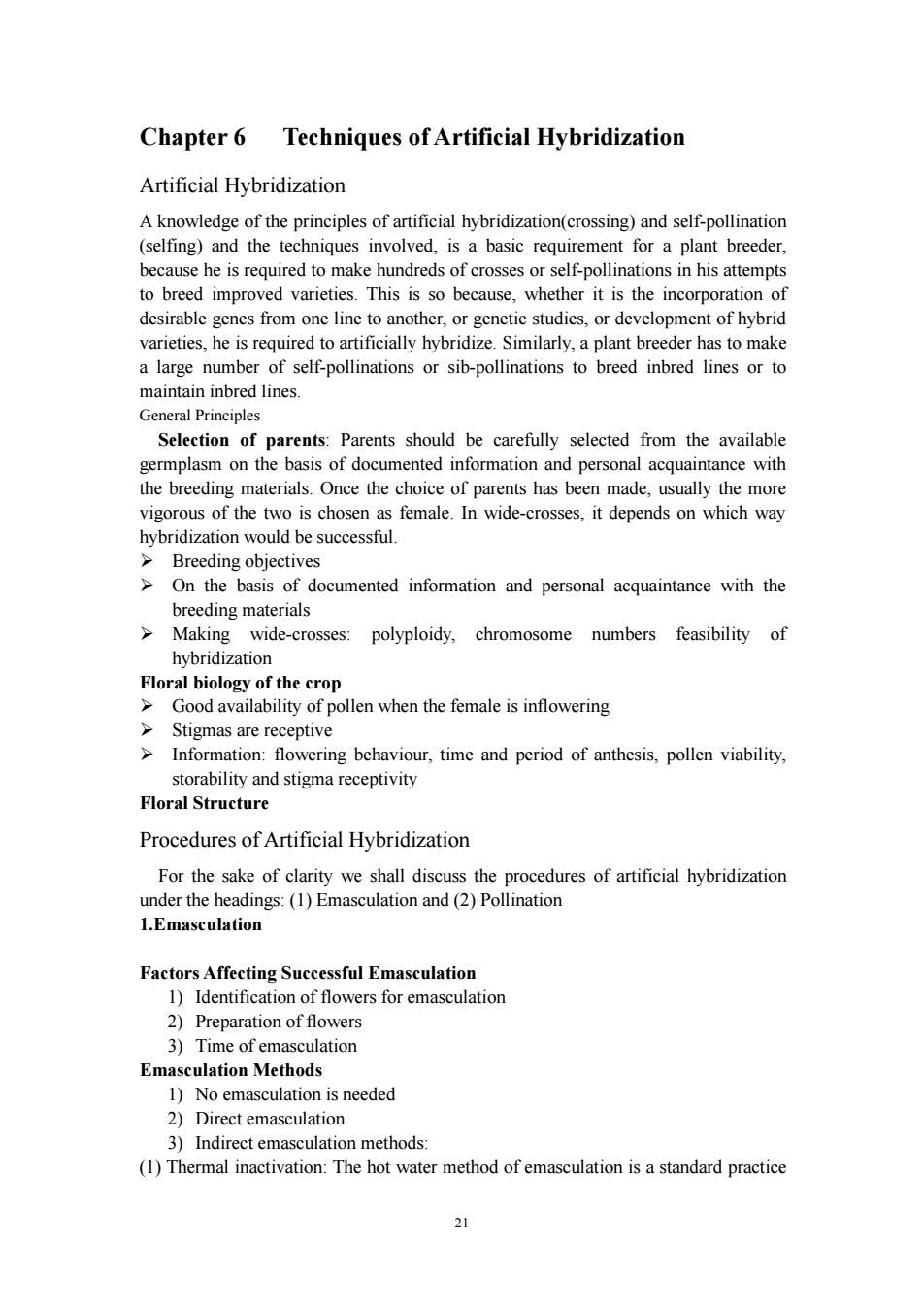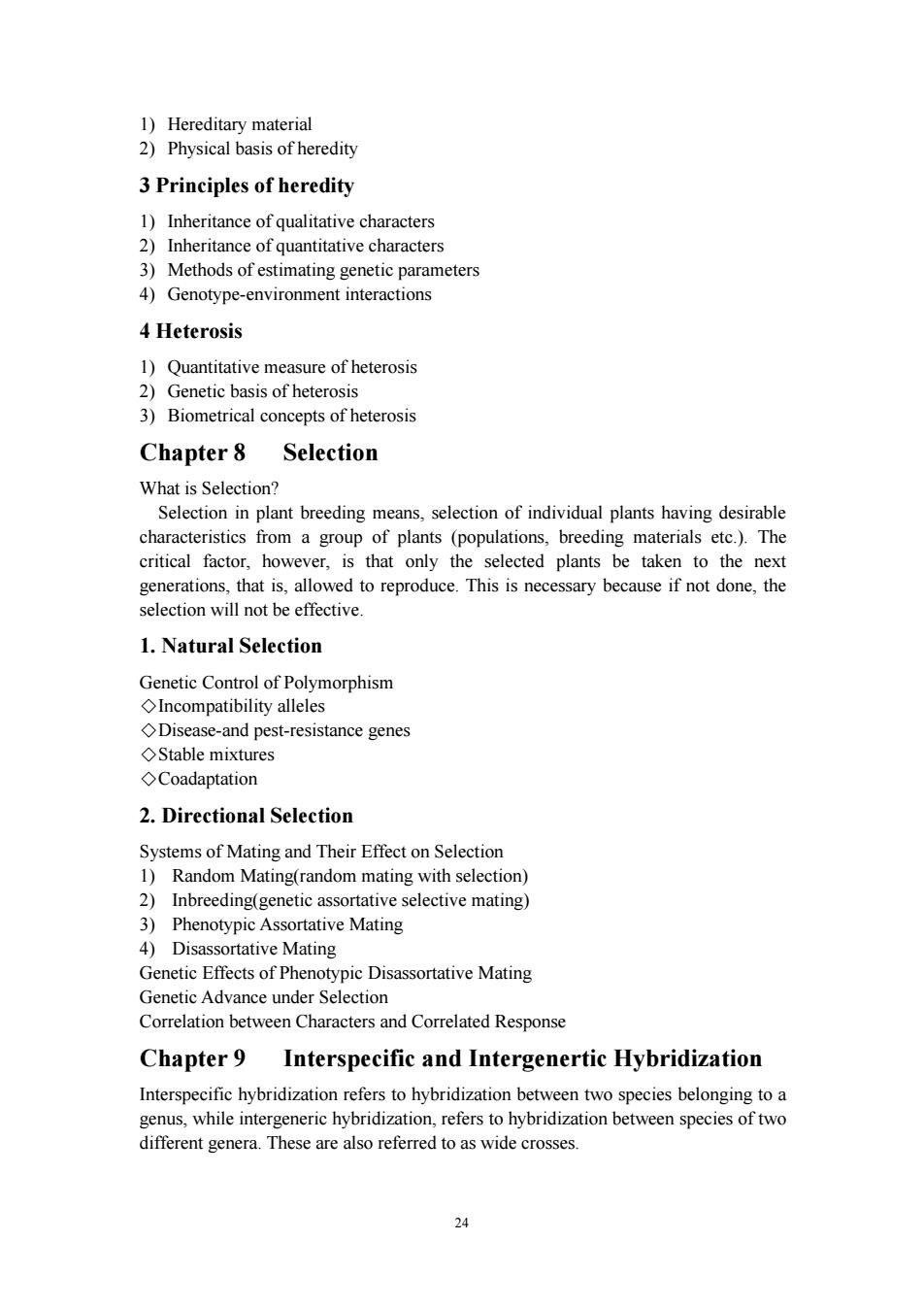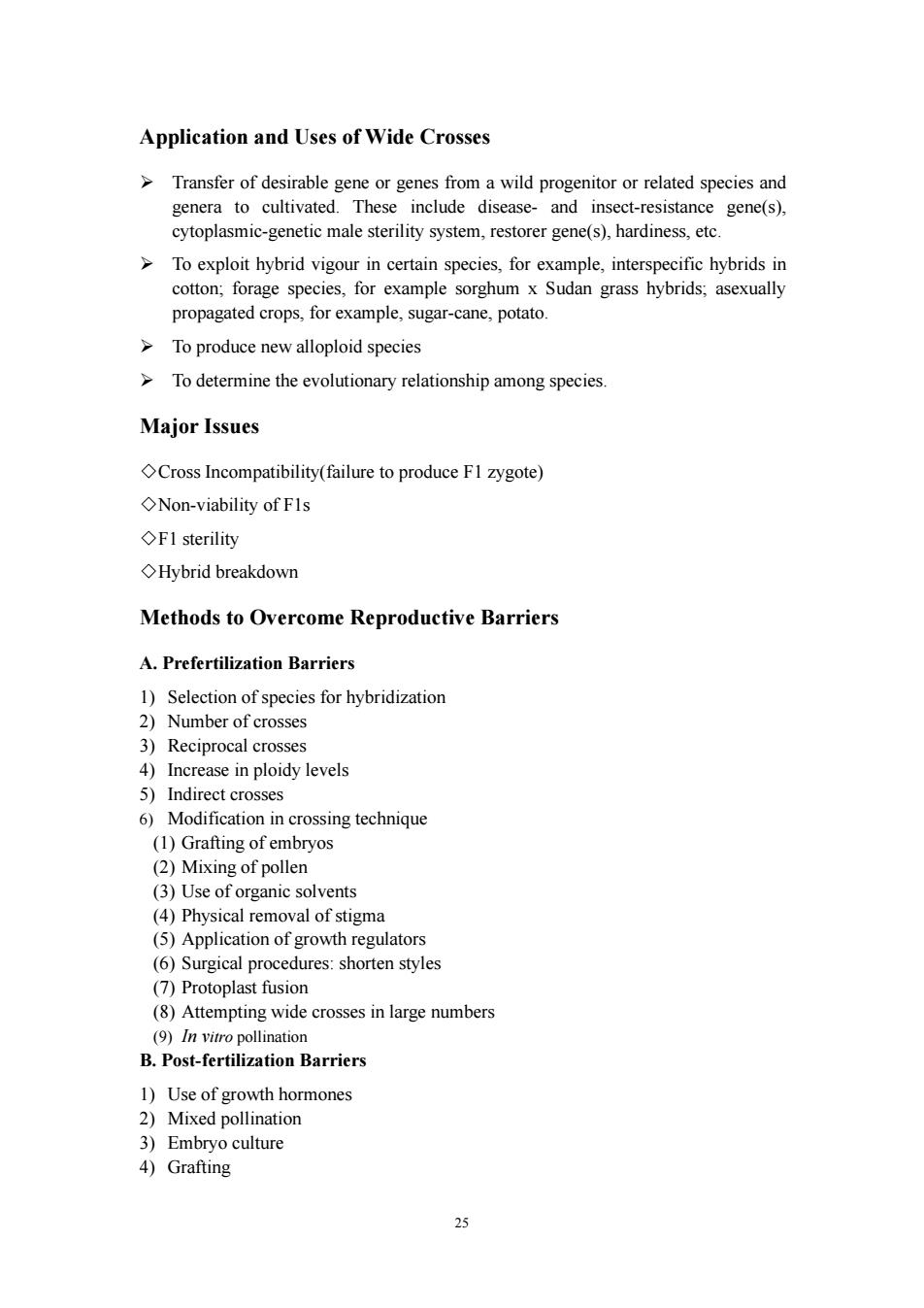
Chapter 6 Techniques of Artificial Hybridization Artificial Hybridization A knowledge of the principles of artificial hybridization(crossing)and self-pollination (selfing)and the techniques involved,is a basic requirement for a plant breeder, because he is required to make hundreds of crosses or self-pollinations in his attempts to breed improved varieties.This is so because,whether it is the incorporation of desirable genes from one line to another,or genetic studies,or development of hybrid varieties,he is required to artificially hybridize.Similarly,a plant breeder has to make a large number of self-pollinations or sib-pollinations to breed inbred lines or to maintain inbred lines. General Principles Selection of parents:Parents should be carefully selected from the available germplasm on the basis of documented information and personal acquaintance with the breeding materials.Once the choice of parents has been made,usually the more vigorous of the two is chosen as female.In wide-crosses,it depends on which way hybridization would be successful. Breeding objectives On the basis of documented information and personal acquaintance with the breeding materials Making wide-crosses:polyploidy,chromosome numbers feasibility of hybridization Floral biology of the crop >Good availability of pollen when the female is inflowering >Stigmas are receptive Information:flowering behaviour,time and period of anthesis,pollen viability, storability and stigma receptivity Floral Structure Procedures of Artificial Hybridization For the sake of clarity we shall discuss the procedures of artificial hybridization under the headings:(1)Emasculation and(2)Pollination 1.Emasculation Factors Affecting Successful Emasculation 1)Identification of flowers for emasculation 2)Preparation of flowers 3)Time of emasculation Emasculation Methods 1)No emasculation is needed 2)Direct emasculation 3)Indirect emasculation methods: (1)Thermal inactivation:The hot water method of emasculation is a standard practice 21
21 Chapter 6 Techniques of Artificial Hybridization Artificial Hybridization A knowledge of the principles of artificial hybridization(crossing) and self-pollination (selfing) and the techniques involved, is a basic requirement for a plant breeder, because he is required to make hundreds of crosses or self-pollinations in his attempts to breed improved varieties. This is so because, whether it is the incorporation of desirable genes from one line to another, or genetic studies, or development of hybrid varieties, he is required to artificially hybridize. Similarly, a plant breeder has to make a large number of self-pollinations or sib-pollinations to breed inbred lines or to maintain inbred lines. General Principles Selection of parents: Parents should be carefully selected from the available germplasm on the basis of documented information and personal acquaintance with the breeding materials. Once the choice of parents has been made, usually the more vigorous of the two is chosen as female. In wide-crosses, it depends on which way hybridization would be successful. Breeding objectives On the basis of documented information and personal acquaintance with the breeding materials Making wide-crosses: polyploidy, chromosome numbers feasibility of hybridization Floral biology of the crop Good availability of pollen when the female is inflowering Stigmas are receptive Information: flowering behaviour, time and period of anthesis, pollen viability, storability and stigma receptivity Floral Structure Procedures of Artificial Hybridization For the sake of clarity we shall discuss the procedures of artificial hybridization under the headings: (1) Emasculation and (2) Pollination 1.Emasculation Factors Affecting Successful Emasculation 1) Identification of flowers for emasculation 2) Preparation of flowers 3) Time of emasculation Emasculation Methods 1) No emasculation is needed 2) Direct emasculation 3) Indirect emasculation methods: (1) Thermal inactivation: The hot water method of emasculation is a standard practice

in some countries for crops such as rice and sorghum.An inflorescence that has just begun to flower is selected.All the open flowers are removed and the inflorescence is dipped in hot water.The temperature of the water and the immersion time vary with the crop(rice,43℃,5min,sorghum,47-48℃,10min).The hot water treatment kills the pollen but does not injure the pistil.After treatment,the infloresence is allowed to dry.Any unopened buds/florets are removed.After drying the infloresence is bagged.Pollination is done 30-60 minutes after treatment. (2)Alcohol emasculation:Emasculation in some crops,for example alfalfa,may be done by immersing the whole raceme in 57%ethanol for 10 seconds and then washing it in water for a few seconds.Species differ in susceptibility of stigma to injury by exposure to alcohol.The seedset is relatively low. (3)Use of chemical gametocides:chemical emasculators (4)Dehiscence control:High humidity is known to delay anther dehiscence and therefore can be used as a tool to facilitate or eliminate emasculation in some grass species in which the flowers open at the time of pollen shed. A panicle is kept in high humidity for several days until the desired number of florets have opened and then hand pollinated. General Precautions The following time-tested safeguard measures may be adopted for excluding contamination either through accidental self-pollinations or natural outcrossing. (1)inspect emasculated flowers for complete anther removal and accidental anther dehiscence.A magnifier may be used to examine flowers that are very small. (2)Rinse the forceps and needles,etc.in alcohol when changing the parents in a crossing block.A similar rinse is needed when anthers accidentally dehisce during emasculation. (3)Cover the emasculated flowers and wherever necessary the unemasculated flowers also to exclude contamination through undesired pollinations and dehiscence of flowers. Labelling The emasculated flowers are usually covered by bagging.Stamping the date on which the flower was bagged helps in determining when the flower is ready for pollination. A label is hung on the stem immediately below the flower to record the date of emasculation,parentage,etc.Later on,when pollination is done,the date of pollination and parentage of pollen parent are added. 2.Pollination Pollen Collection and Storage Male flowera are usually bagged 12 to 24 hours before they are used for pollination to exclude foreign pollen contamination which may have been carried by wind or insects from other sources. The pollen from male flowers is collected the next day or a few days after as the need may be.The best time to collect pollen and implement pollination is during the peak anthesis hours. 22
22 in some countries for crops such as rice and sorghum. An inflorescence that has just begun to flower is selected. All the open flowers are removed and the inflorescence is dipped in hot water. The temperature of the water and the immersion time vary with the crop ( rice, 43 ℃, 5 min; sorghum, 47-48℃, 10min).The hot water treatment kills the pollen but does not injure the pistil. After treatment, the infloresence is allowed to dry. Any unopened buds/florets are removed. After drying the infloresence is bagged. Pollination is done 30-60 minutes after treatment. (2) Alcohol emasculation: Emasculation in some crops, for example alfalfa, may be done by immersing the whole raceme in 57% ethanol for 10 seconds and then washing it in water for a few seconds. Species differ in susceptibility of stigma to injury by exposure to alcohol. The seedset is relatively low. (3) Use of chemical gametocides: chemical emasculators (4) Dehiscence control: High humidity is known to delay anther dehiscence and therefore can be used as a tool to facilitate or eliminate emasculation in some grass species in which the flowers open at the time of pollen shed. A panicle is kept in high humidity for several days until the desired number of florets have opened and then hand pollinated. General Precautions The following time-tested safeguard measures may be adopted for excluding contamination either through accidental self-pollinations or natural outcrossing. (1) inspect emasculated flowers for complete anther removal and accidental anther dehiscence. A magnifier may be used to examine flowers that are very small. (2) Rinse the forceps and needles, etc. in alcohol when changing the parents in a crossing block. A similar rinse is needed when anthers accidentally dehisce during emasculation. (3) Cover the emasculated flowers and wherever necessary the unemasculated flowers also to exclude contamination through undesired pollinations and dehiscence of flowers. Labelling The emasculated flowers are usually covered by bagging. Stamping the date on which the flower was bagged helps in determining when the flower is ready for pollination. A label is hung on the stem immediately below the flower to record the date of emasculation, parentage, etc. Later on, when pollination is done, the date of pollination and parentage of pollen parent are added. 2.Pollination Pollen Collection and Storage Male flowera are usually bagged 12 to 24 hours before they are used for pollination to exclude foreign pollen contamination , which may have been carried by wind or insects from other sources. The pollen from male flowers is collected the next day or a few days after as the need may be. The best time to collect pollen and implement pollination is during the peak anthesis hours

>Immediate use of pollen assures maximum viability and minimizes the time required for pollination. The methods of pollen collection vary in various crops.Pollen may be collected in bulk through the use of mechanical devices,such as mechanical vibrators,in some species. >Maintenance of pollen viability during storage may be necessary when male and female flowers are not available at the same time.The usually methods are storage at low temperatures,at low humidity,and or high relative humidity conditions.The exact procedure varies with the crop species. Pollen Application Self-Incompatible Crops(Bud Pollination) Techniques for Synchronizing Flowering Dates >Delayed planting Manipulation of growing environment:daylength,temperature,relative humidity conditions etc. >Cultural practices:reduced plant population per unit area,removal of the growing point. >Pruning:in many instances pruning(clipping)of leaves without damaging the main stem can delay flowering. Use of hormones:many long-day plants can be induced to flower sooner by the addition of gibberellic acid.Some short-day plants can be induced to flowering by ethylene-producing chemicals. Specific Crossing and Self-Pollination Techniques Chapter 7 Genetic Basis of Plant Breeding 1.Variation 1)Types of variation The variability,that is,the differences observed in individuals of a population or among populations with regard to one or several of its characteristics,is known as variation.This apparent variation,known as phenotypic variation,in turn depends upon the genotypic composition of the population and the environment in which it is raised. (1)Environmental variations (2)Agroecotypic variations 2)Ecotypes The term ecotype'refers to ecological subspecies arising as a result of the differentiation of the species population in response to a particular environment condition. 3)Ecospecies The populations so related that they are able to exchange genes freely without loss of fertility or vigour in the offspring are known as ecospecies. 2.Heredity 23
23 Immediate use of pollen assures maximum viability and minimizes the time required for pollination. The methods of pollen collection vary in various crops. Pollen may be collected in bulk through the use of mechanical devices, such as mechanical vibrators, in some species. Maintenance of pollen viability during storage may be necessary when male and female flowers are not available at the same time. The usually methods are storage at low temperatures, at low humidity, and / or high relative humidity conditions. The exact procedure varies with the crop species. Pollen Application Self-Incompatible Crops ( Bud Pollination) Techniques for Synchronizing Flowering Dates Delayed planting Manipulation of growing environment: daylength, temperature, relative humidity conditions etc. Cultural practices: reduced plant population per unit area, removal of the growing point. Pruning: in many instances pruning(clipping) of leaves without damaging the main stem can delay flowering. Use of hormones: many long-day plants can be induced to flower sooner by the addition of gibberellic acid. Some short-day plants can be induced to flowering by ethylene-producing chemicals. Specific Crossing and Self-Pollination Techniques Chapter 7 Genetic Basis of Plant Breeding 1. Variation 1) Types of variation The variability, that is, the differences observed in individuals of a population or among populations with regard to one or several of its characteristics, is known as variation. This apparent variation, known as phenotypic variation, in turn depends upon the genotypic composition of the population and the environment in which it is raised. (1) Environmental variations (2) Agroecotypic variations 2) Ecotypes The term ‘ ecotype’ refers to ecological subspecies arising as a result of the differentiation of the species population in response to a particular environment condition. 3) Ecospecies The populations so related that they are able to exchange genes freely without loss of fertility or vigour in the offspring are known as ecospecies. 2. Heredity

1)Hereditary material 2)Physical basis of heredity 3 Principles of heredity 1)Inheritance of qualitative characters 2)Inheritance of quantitative characters 3)Methods of estimating genetic parameters 4)Genotype-environment interactions 4 Heterosis 1)Quantitative measure of heterosis 2)Genetic basis of heterosis 3)Biometrical concepts of heterosis Chapter 8 Selection What is Selection? Selection in plant breeding means,selection of individual plants having desirable characteristics from a group of plants (populations,breeding materials etc.).The critical factor,however,is that only the selected plants be taken to the next generations,that is,allowed to reproduce.This is necessary because if not done,the selection will not be effective. 1.Natural Selection Genetic Control of Polymorphism Incompatibility alleles Disease-and pest-resistance genes ◇Stable mixtures ◇Coadaptation 2.Directional Selection Systems of Mating and Their Effect on Selection 1)Random Mating(random mating with selection) 2)Inbreeding(genetic assortative selective mating) 3)Phenotypic Assortative Mating 4)Disassortative Mating Genetic Effects of Phenotypic Disassortative Mating Genetic Advance under Selection Correlation between Characters and Correlated Response Chapter 9 Interspecific and Intergenertic Hybridization Interspecific hybridization refers to hybridization between two species belonging to a genus,while intergeneric hybridization,refers to hybridization between species of two different genera.These are also referred to as wide crosses. 24
24 1) Hereditary material 2) Physical basis of heredity 3 Principles of heredity 1) Inheritance of qualitative characters 2) Inheritance of quantitative characters 3) Methods of estimating genetic parameters 4) Genotype-environment interactions 4 Heterosis 1) Quantitative measure of heterosis 2) Genetic basis of heterosis 3) Biometrical concepts of heterosis Chapter 8 Selection What is Selection? Selection in plant breeding means, selection of individual plants having desirable characteristics from a group of plants (populations, breeding materials etc.). The critical factor, however, is that only the selected plants be taken to the next generations, that is, allowed to reproduce. This is necessary because if not done, the selection will not be effective. 1. Natural Selection Genetic Control of Polymorphism ◇Incompatibility alleles ◇Disease-and pest-resistance genes ◇Stable mixtures ◇Coadaptation 2. Directional Selection Systems of Mating and Their Effect on Selection 1) Random Mating(random mating with selection) 2) Inbreeding(genetic assortative selective mating) 3) Phenotypic Assortative Mating 4) Disassortative Mating Genetic Effects of Phenotypic Disassortative Mating Genetic Advance under Selection Correlation between Characters and Correlated Response Chapter 9 Interspecific and Intergenertic Hybridization Interspecific hybridization refers to hybridization between two species belonging to a genus, while intergeneric hybridization, refers to hybridization between species of two different genera. These are also referred to as wide crosses

Application and Uses of Wide Crosses >Transfer of desirable gene or genes from a wild progenitor or related species and genera to cultivated.These include disease-and insect-resistance gene(s), cytoplasmic-genetic male sterility system,restorer gene(s),hardiness,etc. >To exploit hybrid vigour in certain species,for example,interspecific hybrids in cotton;forage species,for example sorghum x Sudan grass hybrids;asexually propagated crops,for example,sugar-cane,potato. To produce new alloploid species To determine the evolutionary relationship among species. Major Issues Cross Incompatibility(failure to produce F1 zygote) ◇Non-viability of Fls ◇F1 sterility ◇Hybrid breakdown Methods to Overcome Reproductive Barriers A.Prefertilization Barriers 1)Selection of species for hybridization 2)Number of crosses 3)Reciprocal crosses 4)Increase in ploidy levels 5)Indirect crosses 6)Modification in crossing technique (1)Grafting of embryos (2)Mixing of pollen (3)Use of organic solvents (4)Physical removal of stigma (5)Application of growth regulators (6)Surgical procedures:shorten styles (7)Protoplast fusion (8)Attempting wide crosses in large numbers (9)In vitro pollination B.Post-fertilization Barriers 1)Use of growth hormones 2)Mixed pollination 3)Embryo culture 4)Grafting 25
25 Application and Uses of Wide Crosses Transfer of desirable gene or genes from a wild progenitor or related species and genera to cultivated. These include disease- and insect-resistance gene(s), cytoplasmic-genetic male sterility system, restorer gene(s), hardiness, etc. To exploit hybrid vigour in certain species, for example, interspecific hybrids in cotton; forage species, for example sorghum x Sudan grass hybrids; asexually propagated crops, for example, sugar-cane, potato. To produce new alloploid species To determine the evolutionary relationship among species. Major Issues ◇Cross Incompatibility(failure to produce F1 zygote) ◇Non-viability of F1s ◇F1 sterility ◇Hybrid breakdown Methods to Overcome Reproductive Barriers A. Prefertilization Barriers 1) Selection of species for hybridization 2) Number of crosses 3) Reciprocal crosses 4) Increase in ploidy levels 5) Indirect crosses 6) Modification in crossing technique (1) Grafting of embryos (2) Mixing of pollen (3) Use of organic solvents (4) Physical removal of stigma (5) Application of growth regulators (6) Surgical procedures: shorten styles (7) Protoplast fusion (8) Attempting wide crosses in large numbers (9) In vitro pollination B. Post-fertilization Barriers 1) Use of growth hormones 2) Mixed pollination 3) Embryo culture 4) Grafting